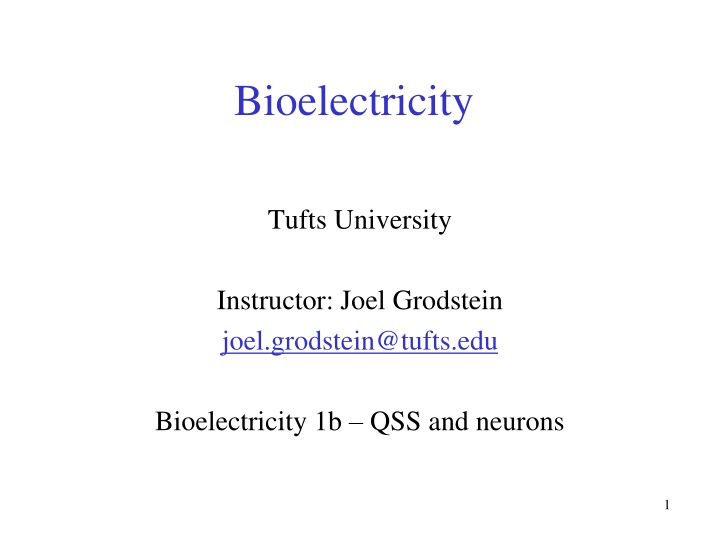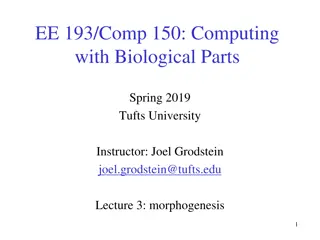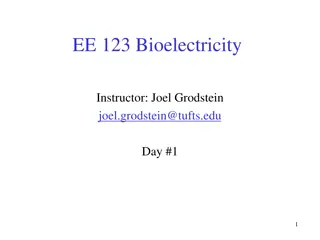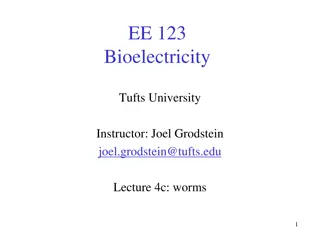Bioelectricity
Dive into the intriguing world of bioelectricity, exploring the intricate connections between Quantum Sensory Science (QSS) and neurons. Join Instructor Joel Grodstein from Tufts University in this captivating study of bioelectricity's role in the nervous system. Gain insights into the fundamental principles governing the electrical activity of neurons and discover the impact of bioelectricity on various physiological processes.
Download Presentation

Please find below an Image/Link to download the presentation.
The content on the website is provided AS IS for your information and personal use only. It may not be sold, licensed, or shared on other websites without obtaining consent from the author.If you encounter any issues during the download, it is possible that the publisher has removed the file from their server.
You are allowed to download the files provided on this website for personal or commercial use, subject to the condition that they are used lawfully. All files are the property of their respective owners.
The content on the website is provided AS IS for your information and personal use only. It may not be sold, licensed, or shared on other websites without obtaining consent from the author.
E N D
Presentation Transcript
Bioelectricity Tufts University Instructor: Joel Grodstein joel.grodstein@tufts.edu Bioelectricity 1b QSS and neurons 1
Big picture of the course Where does bioelectricity come from? Neurons and working with the nervous system Cardiac bioelectricity Worms EE 123 Joel Grodstein 2
VLab #1, first plots Bioelectricity Joel Grodstein 3
Problem for the day We ran a bunch of simulations of cells They created voltage. Cool! Minor problem: Our sims took several hours of simulated time to reach steady state Our brains run on bioelectricity Any problem there? Bioelectricity Joel Grodstein 4
How can our brain be so fast? We humans can think pretty fast We can react pretty fast, too Cannot work if each neuron takes hours to settle! Result: humans evolved a new way to use bioelectricity Operation at quasi-steady-state It s how neurons work Levin-lab hypothesis Steady-state bioelectricity is used to build body shape We re in the womb for 9 months Our cuts & scrapes heal over days/weeks But it s not OK for brains Or for animorphs https://www.youtube.com/watch?v=jEKPDgjERt0&list=PL9AC274019AC09106& index=5 5 Bioelectricity Joel Grodstein
What we will learn How to use bioelectricity to compute really fast This will be how neurons work Hypothesis: cells communicated slowly via bioelectricity for eons And then evolution figured out a trick Bioelectricity Joel Grodstein 6
Why did lab1 run so slow? From lab1, t=5000 net Cl flux=20e-4 mol/m3s [Cl]init=55mol/m3 We re trying to drain a small cell with a very small siphon How can we possibly get around this problem? Bioelectricity Joel Grodstein 7
How can Vmem change quickly? diffusion currents are high. ??????= ?? ?? Compare ICF vs. ECF [Na], [K], [Cl] What is the net ECF, ICF charge? ICF, ECF each has a lot of charge Biology has built sensitive sensors we need only move Vmem by 50mV ?? small absolute q is a large relative q. Drift currents are quite high. Lots of ions packed densely, all moving even slowly lots of cars passing/second 60mV --- +++ [K+]=400mM [Na+]=50mM [Cl-]=52mM Pr -=399mM [K+]=20mM [Na+]=440mM [Cl-]=560mM other+=101mM q = CV, q = C V. So C and V are small, which means so is q. 3Na+ 2K+ Bioelectricity Joel Grodstein 8
Back of the envelope speed Quick electricity problem: If the cell membrane is a capacitor C How much charge qmust enter the cell to change the voltage by V? q=C V Typical planaria values: Radius of a cell = 5 Capacitance of the cell membrane = .05 F/m2 V = 50mV What is q? How long will it take to move Vmem by 50mV? Current = 2.5*10-12 C/s Area of membr. = C = 4 * * (5 )2= 3x10-10 m2 (3x10-10 m2) * (.05 F/m2) =15x10-12 F (15x10-12 F)(.050V) = .75x10-12 C q = C V = .75 10 12? 1 ? 2.5 10 12?= .3? Time = Bioelectricity Joel Grodstein 9
Contrast in time scales Vmem initially changes quickly, then slowly Ion concentrations change slowly Clearly sensing Vmem changes is faster than sensing conc. changes But why the slow Vmem ramp after its initial surge? Bioelectricity Joel Grodstein 10
It only takes .3s to move Vmem around as much as needed! That s a planaria; humans are <1ms More fun facts anybody know why human nerves are so much faster than worms? That s a lot faster than hours! Nice, but Bioelectricity Joel Grodstein 11
So why the two Vmem ramps? --- +++ 60mV 50mV 3Na+ [K+]=400mM [Na+]=50mM [Cl-]=52mM other-=408mM [K+]=20mM [Na+]=440mM [Cl-]=560mM other+=110mM 2K+ Blue arrows = diffusion Green arrows = electric current Red arrows = ion pump If we increase GNa Na+ is flowing inwards from both diffusion and drift, and then being pumped out Increasing GNa will increase the inwards flow; and not affect the outwards flow Analyzing only Na for now More [Na]int Vmem Higher Vmem pushes Na+ out again This is negative feedback Vmem rises reduced drift balances increased diffusion Concentrations barely change, so it s fast Vmem will get more positive (i.e., closer to 0) fast or slow? Are we done yet? At this new Vmem, is the flow of, say, Cl- balanced? very fast 12 Bioelectricity Joel Grodstein
Were not at steady state --- +++ 50mV 3Na+ [K+]=400mM [Na+]=50mM [Cl-]=52mM other-=408mM [K+]=20mM [Na+]=440mM [Cl-]=560mM other+=110mM 2K+ Blue arrows = diffusion Green arrows = electric current Red arrows = ion pump Cl-has no pump. It s only balanced when drift=diffusion. Are they balanced? Cl-diffusion is unchanged, but drift is changed Cl- is not balanced Ditto for K+, in fact What must change for Cl- to balance again at this new Vmem? ICF [Cl] must change enough to make a new diffusion But that is what takes hours and not ms. Remember: unbalanced charge flow changes Vmem very fast, but [] changes slowly So what s going on? Why do we think we can compute fast? 13 Bioelectricity Joel Grodstein
VLab #1 picture again This time in more detail, from t=0 to t=30: really fast change really slow change Bioelectricity Joel Grodstein 14
50mV --- +++ 60mV 3Na+ [K+]=400mM [Na+]=50mM [Cl-]=9mM other-=408mM [K+]=5mM [Na+]=145mM [Cl-]=140mM 2K+ Blue arrows = diffusion Green arrows = electric current Red arrows = ion pump Big picture: if you make Vmem more positive Diffusion and pump flows are unchanged Drift currents push positive ions out, negative ions in 15 Bioelectricity Joel Grodstein
flux (mM/m2s) into cell Na drift+diff K pump -71 0 Vmem (mV) K drift+diff Na pump The situation at SS, -71mV before we changed GNa: Pump 3 Na out, 2 K in Drift & diffusion must balance the pump Now increase GNa Na drift and diffusion are both in flux increases Generally, more positive Vmem pos. charges drift out Any guesses how I drew the slope of these two lines? Bioelectricity Joel Grodstein 16
flux (mM/m2s) into cell Na drift+diff K pump -71 0 Vmem (mV) K drift+diff Na pump Na has net flow in so Vmem becomes more positive But how much more positive? We can pick a new Vmem to balance Na but then K isn t balanced What is the right Vmem? Bioelectricity Joel Grodstein 17
flux (mM/m2s) into cell charge (C/m2s) into cell Na drift+diff K pump -71 0 Vmem (mV) K drift+diff Na pump Net 0 charge into cell Net - charge into cell Net + charge into cell Add Cl to the picture There is some increased Vmem with net zero charge into the cell! Can you argue that this is where we settle to? Can you argue that we settle here pretty quickly? Bioelectricity Joel Grodstein 18
flux (mM/m2s) into cell charge (C/m2s) into cell Na drift+diff K pump -71 0 Vmem (mV) K drift+diff Na pump Net 0 charge into cell Net + charge into cell Net - charge into cell No individual ion is balanced Non-zero charge flux into cell for each of Na, K, Cl But they all cancel out! Bioelectricity Joel Grodstein 19
VLab #1 picture again This time in more detail, from t=0 to t=30: really fast change really slow change QSS no change SS Bioelectricity Joel Grodstein 20
In-class exercise In a few sentences, explain how neurons can operate so fast If a cell is at some Vmem higher or lower than the net-charge-flux-equals-0 voltage, what is the mechanism to quickly fix this? How is this a negative-feedback system? Bioelectricity Joel Grodstein 21
Which Vmem does KCL compute? ICF IK INa 2.2 .4 .4 60 40 ? ? ?? ??? ? ??? -89mV -71mV ECF 77mV Does KCL compute the QSS Vmem or the SS Vmem? It says the sum of currents into ICF = 0 Even though they re from different ions! Our equivalent circuit computes QSS Vmem Bioelectricity Joel Grodstein 22
Circuit model computes Vmem ICF IK INa 2.2 .4 .4 60 40 ? ? ?? ??? ? ??? -89mV -71mV ECF 77mV Units? G is ?????? Ipump is ?????? Note the 3:2 ratio of pump currents ?3 ? per mVolt ?3 ? Bioelectricity Joel Grodstein 23
In-class exercise ICF IK INa 2.2 .4 .4 60 40 ? ? ?? ??? ? ??? -89mV -71mV ECF 77mV Write KCL on the ICF node ? ???????= 0 ? ???????+ ?? ? ??????+ ??? ?? ???+ ??? Solve it for Vmem ???? ????+?? ???+??+??? ???+??? ?? ???+??? ????= What value do we get? 40 60 +77 .4 89 2.2 71 (.4) .4 +2.2+.4 = -71.13mV ????= Bioelectricity Joel Grodstein 24
KCL = biology? ICF IK INa 2.2 .4 .4 60 40 ? ? ?? ??? ? ??? -89mV -71mV ECF 77mV What is KCL really doing? It s saying that the sum of currents into the node = 0 We already said the cell quickly settles at a Vmem where net flux = 0 These are the same thing! KCL computes the Vmem that we quickly settle to But ignores how long it takes to get there Any idea how to fix that? Bioelectricity Joel Grodstein 25
Individual ion currents Vmem=-71mV ICF IK INa 2.2 .4 .4 Compute the current for each ion 60 40 ? ? ?? ??? ? ??? -89mV -71mV ECF 77mV Na ion channel = (77 - -71) * .4 60 entering the cell pump = 60 leaving the cell Cl Voltage drop across resistor = ? Current = ? K ion channel = ? pump = ? 40 entering the cell Are we in SS or QSS? (-71) - (-71) = 0 mV V/R = 0 (-89 - -71) * 2.2 -40 entering the cell 26 Bioelectricity Joel Grodstein
What if we change GNa? Vmem=-71mV ICF IK INa 2.2 .4 .4 I.e., turn on more Na ion channels? (lookahead neurons do this) We used graphs to predict the outcome of changing GNa What does the model predict? 60 40 ? ? ?? ??? ? ??? -89mV -71mV ECF 77mV 27 Bioelectricity Joel Grodstein
Vmem=-71mV Vmem=19mV ICF IK INa 2.2 .4 5 .4 60 40 ? ? ?? ??? ? ??? -89mV 77mV ECF -71mV Let s increase GNa Rough guess as to what the model predicts? We ve tied Vmem more tightly to VNNa, and so Vmem moves closer to +77mV than -89mV ???? ????+?? ???+??+??? 5 5 ???+??? ?? ???+??? ????= 40 60 + 77 .4 89 2.2 71 (.4) .4 +2.2+.4 = = -71mV 19 Bioelectricity Joel Grodstein 28
Vmem=+19mV ICF Cl: (-71-19)*.4 -36 Na: (77-19)*5 292 IK INa 2.2 5 .4 60 40 ? ? ?? ??? ? ??? K: (-89-19)*2.2 -236 -89mV 77mV ECF -71mV Let s look at the new currents Here s the math, above Which way does Na flow? K? Cl? Observation: each ion is individually unbalanced! In total: net charge flow into cell via ion channels = net flow leaving via pumps = Into the cell, since Vmem=19mV and 19<77 Out of the cell, since 19 > -89 Charge out (Cl in) the cell, since 19 > -71 292 -236 - 36 = 20 60 - 40 = 20 Are we in SS or QSS? Bioelectricity Joel Grodstein 29
Whats going on? Vmem=19mV ICF IK INa 292 236 36 60 40 ? ? ?? ??? ? The model predicted SS once and QSS once. Why? Settling to the new QSS value will happen quickly Do ion concentrations change much in this short time? No, they can t Is there any slow process that the schematic doesn t model? Each ion has nonzero flux concentration slowly changes How does that concentration change affect our model parameters? VNernst changes slowly ??? -89mV -71mV ECF 77mV 30 Bioelectricity Joel Grodstein
Setup: GNa and GK originally set for -71mV At t=100s, they suddenly change Eventually we reach true SS Na+ K+ Cl- Thus so does Vmem Dynamic phase: Vmem swinging rapidly QSS: concentrations changing very slowly Bioelectricity Joel Grodstein 31
QSS big picture Change how many Na, K ion channels are on and that quickly swings Vmem positive, negative That s how neurons work Large-scale [Na], [K], [Cl] don t really change Bioelectricity Joel Grodstein 32
Summary ICF We have a nice equivalent circuit that we can analyze IK INa GK GNa GCl ? ? ?? ??? ? ??? -89mV -71mV ECF 77mV The VNernst values come from ion concentrations G values depend on how many ion channels are turned on KCL on the ICF node: ? ???????= 0 ? ???????+ ?? ? ??????+ ??? ??? ???+??+???+ ?? ?? ???+ ??? ?? ??? ???+??+???+ ??? ??? ???+??+??? ?? ? ? ????= ???+??+???+ ? ??? Bioelectricity Joel Grodstein 33
Ion channels, QSS and SS Change G value Vmem changes rapidly (ms to seconds) The trick: high concentrations of all ions in ICF and ECF, but their charges nearly cancel out Large-scale concentrations change much more slowly (minutes to hours) quasi-steady state Eventually we reach a new steady state again, where each ion flux is 0 Bioelectricity Joel Grodstein 34
Whats up next? Done with the physics part of the course! You understand bioelectricity fairly deeply Python Lab #2, cell voltages in QSS Reinforces that voltages change fast Oral quiz reinforces that GNa and GK are your knobs to swing Vmem Now onto the medical/applications part Then onto current research Bioelectricity Joel Grodstein 35
Mini quiz (prep for the oral quiz) ICF IK INa GK GNa GCl ? ? ?? ??? ? ??? -89mV -71mV ECF 77mV What is the value of Vmem if, e.g., GNa gets very big? What is the value of Vmem if, e.g., GK gets very big? What if GNa and GK are both close to 0? Bioelectricity Joel Grodstein 36
BACKUP Bioelectricity Joel Grodstein 37
analyze_equiv_network() tries to keep results pretty It sometimes only prints to one significant digit Here are some better numbers Na 3.19 71 810 K 38.4 -86 540 Cl 4.44 -25 G (mol/m2s per mV) Vnernst (mV) Ipump (mol/m2s) Bioelectricity Joel Grodstein 38





